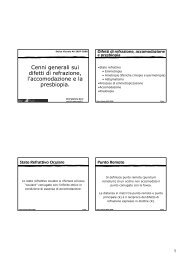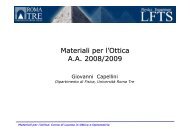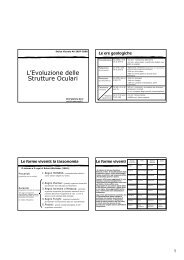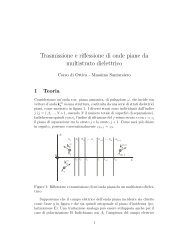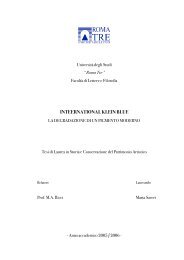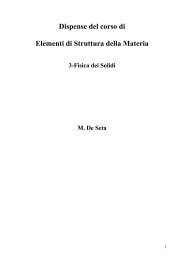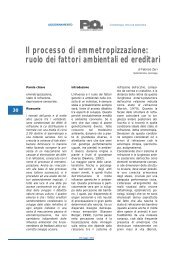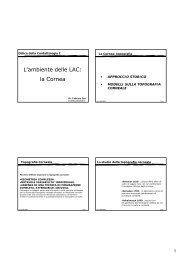The ESPERIA Project - Università degli Studi Roma Tre
The ESPERIA Project - Università degli Studi Roma Tre
The ESPERIA Project - Università degli Studi Roma Tre
You also want an ePaper? Increase the reach of your titles
YUMPU automatically turns print PDFs into web optimized ePapers that Google loves.
<strong>ESPERIA</strong><br />
Un progetto di missione spaziale<br />
per lo studio di perturbazioni<br />
nella zona di transizione<br />
ionosfera-magnetosfera<br />
Vittorio Sgrigna (P.I.)<br />
Universita’ e Sez. INFN<br />
<strong>Roma</strong> <strong>Tre</strong>
Gruppo Gruppo E E s s p p e e r r i i aa<br />
G G G r r r u u u p p p p p p o o o<br />
E E E s s s p p p e e e r r r i i i aa<br />
a<br />
•Prof. Vittorio Sgrigna Tel. Uff. +39 06 55177227 sgrigna@fis.uniroma3.it<br />
•Prof. David Zilpimiani<br />
•Dr. Aurora Buzzi Tel. Lab. +39 06 55177090 buzzi@fis.uniroma3.it<br />
•Dr. Livio Conti Tel. Lab. +39 06 55177090 contil@fis.uniroma3.it
<strong>ESPERIA</strong>:<br />
Earthquake investigations by Satellite and Physics of the<br />
Environment Related to the Ionosphere and Atmosphere<br />
<strong>ESPERIA</strong> (Earthquake investigations by Satellite and Physics of the Environment Related to the Ionosphere<br />
and Atmosphere) is a scientific proposal (Principal Investigator: Vittorio Sgrigna) for the investigation of<br />
ionospheric perturbations due to the seismic activity and to the Earth electromagnetic environment. <strong>The</strong><br />
participants to the <strong>ESPERIA</strong> project are scientists involved in geophysics, seismology, cosmic physics, radio<br />
physics, and particle physics.<br />
<strong>The</strong> proposal includes both on board satellite observations and ground-based measurements. On board the<br />
satellite ULF, ELF, VLF, HF electromagnetic fields, charged particle fluxes, and ionospheric plasma<br />
parameters will be measured. Ground based measurements of mechanical (tilt and strain) and<br />
electromagnetic (ULF, ELF, VLF, HF) fields will be carried out. <strong>The</strong> project also includes the monitoring of<br />
ionospheric perturbations due to the anthropogenic electromagnetic emission (power line harmonic<br />
radiation, VLF transmitters, HF broadcasting stations).<br />
<strong>The</strong> proposal has been developed within the framework of a call for a mission of the Italian Space Agency<br />
(ASI) for a micro-satellite dedicated to Earth Sciences. First satellite observations concerning the<br />
precipitation of charged particle fluxes from the lower boundary of the Van Allen radiation belt were made<br />
in 1985 during the MARIA experiment carried out on board the SALYUT-7 orbital station. Most of these<br />
events were detected near the South Atlantic Anomaly (SAA). Further investigations, carried out by other<br />
orbital stations and satellites (Maria 2, Meteor 3A, ELECTRON and GAMMA 1), confirmed previous<br />
observations. <strong>The</strong> main observations and theoretical explanations can be found in the references listed<br />
below. On board the satellite we plan to install a particle detector, a Langmuir probe and a retarding<br />
potential analyzer for plasma investigations, electric and magnetic analyzers. Local and global seismic<br />
networks together with Zollner pendulum tiltmeters (TELLUS network), differential electromagnetic<br />
strainmeters, and electric and magnetic analyzer instrumental networks will be used in ground-based<br />
measurements.
Seismo-EM<br />
&<br />
Anthropogenic<br />
Emissions<br />
Thunderstorm<br />
Activity<br />
Main Issues of the <strong>ESPERIA</strong> Space Mission <strong>Project</strong><br />
Ionospheric<br />
interaction region<br />
Mirror<br />
point<br />
PBs<br />
Mirror<br />
point<br />
Trajectory of<br />
trapped particles<br />
Lower boundary of the<br />
inner radiation belt<br />
External Sources<br />
(Sun & Cosmic Rays)<br />
• Magnetospheric Dynamics<br />
• Ionospheric Perturbations<br />
• Geomagnetic Field Fluctuations<br />
• Seismic Precursors
<strong>The</strong> <strong>ESPERIA</strong> general project<br />
Designed to<br />
Study of near-Earth EM, plasma, and particle environment<br />
in steady-state and perturbed-state conditions.<br />
Planned with<br />
• Magnetic equatorial mission<br />
• LEO satellite<br />
• Multi-instrument payload<br />
Privileged region of investigation<br />
Ionosphere-magnetosphere transition zone<br />
Detectable phenomena<br />
• Earth’s interior processes & Anthropogenic emissions<br />
• Atmosphere-Ionosphere-Magnetosphere couplings<br />
• Sun activity & Cosmic rays
<strong>ESPERIA</strong> Phase A Study (Italian Space Agency)<br />
Scientific objectives<br />
Primary:<br />
• seismo-electromagnetic emissions<br />
Secondary: • man-made EM emissions<br />
Scientific program & observations<br />
Coordinated, simultaneous, and continuous<br />
ground-based and space observations
Ground-based Mechanical Observations<br />
T<br />
Intermediate-term tilt precursors (≈ weeks÷months)<br />
Preseismic fault creep events: events 1997 Umbria-Marche<br />
Umbria Marche seismic sequence<br />
iltmeter network<br />
Crustal rustal block structure<br />
Tilt ilt Data<br />
T he Model
Loma Prieta earthquake,<br />
October 18, 1989, M=7.1<br />
(Fraser-Smith et al., 1990)<br />
Spitak earthquake, December 7,<br />
1988, M = 6.9<br />
(Kopytenko et al., 1993)<br />
G<br />
Ground-based round-based EME observations
EME space observations<br />
Electric field anomalies in the ULF-ELF range detected<br />
by AUREOL-3 satellite in coincidence of an earthquake<br />
of M=5.1, 17/3/1982 (Parrot & Mogilevsky, 1989).<br />
EME ULF/ELF anomalies recorded contemporarily<br />
by AUREOL-3 and IKB-1300 satellites 4h before the<br />
Spitak’s aftershock of M=5.2. [Galperin et al 1992].
Correlations between Earthquakes & Particle Bursts: ∆TEQ-PB distributions<br />
MIR mission<br />
1985-2000<br />
Altitude: 400 km<br />
Inclination: 51°<br />
E e : 20 ÷ 200 MeV<br />
E p : 20 ÷ 200 MeV<br />
METEOR-3 mission<br />
1985-1986<br />
Altitude: 1250 km<br />
Inclination: 82°<br />
E e : ≤ 30 MeV<br />
GAMMA mission<br />
1990-1992<br />
Altitude: 350 km<br />
Inclination: 51°<br />
E e : > 50 MeV<br />
ORR(Orbit Rate Rotation;<br />
July 1992 - May 1994)<br />
SAMPEX/PET mission<br />
1992-1999<br />
Altitude: 520 ÷ 740 km<br />
Inclination: 82°<br />
4 ≤ E e ≤ 15 MeV
Payload Instruments:<br />
Electric Field Analyser (EFA)<br />
• frequency range: ~DC ÷ 10 MHz<br />
• accuracy: 300 nV/m<br />
• dynamic range: 120 dB<br />
Magnetic Field Analyser (MAFA)<br />
FLUX – GATE: • frequency range: ~DC ÷ 10 Hz<br />
• accuracy: a few (6-8) pT<br />
• resolution: 24 bit<br />
SEARCH – COIL: • frequency range: ~10 Hz ÷ 100 kHz<br />
• sensitivity:10 -2 pT /(Hz)½ (at 1 kHz)<br />
Langmuir Probe & Retarding Potential Analyser<br />
LP: • electron temperature: 300 ÷ 15000 K<br />
• electron density: 10 2 ÷ 10 7 cm -3<br />
RPA: • ionic temperature: 300 ÷ 10000 K<br />
• ionic density: 10 2 ÷ 10 7 cm -3<br />
Particle Detector Analyser (PDA).<br />
• Energy range: 300keV÷2GeV<br />
• Pitch angle accuracy < 4 o with particle identification<br />
• Geometry: 5 silicon strip telescopes + 1 calorimeter &<br />
1 silicon strip telescope + 1 calorimeter<br />
Electric probes A<br />
FLUX-GATE<br />
PDA<br />
LP&RPA<br />
Zenith<br />
SEARCH-COIL<br />
V<br />
Electric probes B
Orbit Characteristics<br />
• Ground track repetition with an accuracy of 10 km<br />
(high-accuracy Earth’ surface monitoring) 30<br />
• Revisit time: ≤ 24 h<br />
• Geosynchronous orbit: 14 orbits / day<br />
• Altitude: 813 km<br />
• Inclination: 11°.5<br />
• Eccentricity: 0<br />
• Orbit period: 110 min<br />
• Maximum oscillation around the magnetic equator: ± 23°<br />
• Field of view: ± 39°<br />
11.5 degrees orbit<br />
• Orbit knowledge and time resolution ≈ 100 m and 1s, respectively<br />
Spacecraft<br />
• Platform MITA<br />
• Nadir pointing<br />
• FEEP thrusters applied to the platform (constant altitude)<br />
Mission duration ≥ 2 years<br />
magnetic latitude [deg]<br />
25<br />
20<br />
15<br />
10<br />
5<br />
0<br />
-5<br />
-10<br />
-15<br />
-20<br />
-25<br />
-30<br />
21/03 00<br />
21/03 06<br />
21/03 12<br />
21/03 18<br />
22/03 00<br />
time [dd/mm hh]<br />
22/03 06<br />
22/03 12<br />
22/03 18<br />
23/03 00
EFA sensors<br />
•10 spherical probes mounted on two booms system<br />
Features:<br />
• Two booms system;<br />
• primary boom : 5 meters<br />
• secondary boom: 2 meters<br />
EFA_DU_A4<br />
EFA_DU_A5<br />
EFA_DU_A2<br />
BOOM<br />
SYSTEM A<br />
EFA_DU_A3<br />
EFA_DU_A1<br />
SATELLITE BODY<br />
EFA_DU_B2<br />
EFA_DU_B4<br />
BOOM<br />
SYSTEM B<br />
EFA_DU_B1<br />
EFA_DU_B5<br />
EFA_DU_B3<br />
• Single Probe schematic<br />
Features: Mass:500g<br />
• Spheres with pre-amp. inside<br />
• <strong>The</strong>rmal control<br />
• DC Current Bias<br />
sphere sensor<br />
Power: 1W
MAFA sensors<br />
• Vectorial instruments: search coils and fluxgates<br />
Features:<br />
• Two MAFA sensors<br />
• Fluxgate (DC-10Hz)<br />
• Search Coils (10Hz-100KHz)<br />
MAFA_DU_SC1/2/3<br />
(three axes<br />
search-coils)<br />
Search Coils possible supplier :MEDA inc.,<br />
22611 Market Court Suite 114 Dulles, VA<br />
20166<br />
Mass:715g<br />
Search coil sensor<br />
Power:
LP&RPA sensors<br />
• LP sensor for plasma density,<br />
electron temperature,<br />
plasma potential,<br />
floating potential analysis.<br />
• RPA sensor for ion energy spectrum<br />
Particle Detector Analyzer<br />
6 High Energy Detectors:<br />
20 MeV ÷ 2 GeV<br />
6 Medium Energy Detectors:<br />
300 keV ÷ 30 MeV<br />
particle entrance<br />
PDA_CDU_2<br />
PDA_SDU_6<br />
PDA_SDU_1<br />
particle entrance<br />
PDA_SDU_2<br />
PDA_SDU_5<br />
PDA_CDU_1<br />
PDA_SDU_4<br />
particle entrance<br />
PDA_SDU_3<br />
particle entrance<br />
LP&RPA box<br />
Mass:400gr<br />
Power: 4.7W<br />
LP& RPA Boxes developed at<br />
LABEN/Proel Tecnologie Division<br />
for SMART-1 & Stentor satellite
Participants<br />
Institute of Physics of the Earth, RAS (Russian Fed.)<br />
GAS<br />
Institutes<br />
University <strong>Roma</strong> <strong>Tre</strong> &<br />
INFN Section, Rome (Italy)<br />
University Tor Vergata &<br />
INFN Section, Rome (Italy)<br />
University of Rome “La Sapienza” (Italy)<br />
University of Florence & INFN Section (Italy)<br />
University of L'Aquila & INFN Section (Italy)<br />
INGV, Rome (Italy)<br />
LPCE/CNRS-CNES, Orleans (France)<br />
MEPhI, Institute of Cosmic Physics, Moscow (Russia)<br />
Institute of Geophysics, Tiblisi (Georgian Rep.)<br />
St. Petersburg University (Russian Fed.)<br />
University of Athens (Greece)<br />
IFSI-CNR, Rome (Italy)<br />
IFAC-CNR, Florence (Italy)<br />
University and Polytechnic of Milan (Italy)<br />
LABEN S.p.A. (Italy) (payload)<br />
CARLO GAVAZZI SPACE S.p.A. (Italy) (satellite)<br />
TELESPAZIO S.p.A. (ground segment)<br />
Participants<br />
V. Sgrigna (Principal Investigator), A. Buzzi,<br />
L. Conti, M. Parisi, L. Stagni<br />
P. Picozza (P.I.-PAMELA), M. Casolino,<br />
M.P. De Pascale.<br />
M. Caputo, P. Dominici<br />
P.Spillantini<br />
R. Scrimaglio, N. Finetti, L. Carota<br />
R. Console<br />
M. Parrot (P.I.-DEMETER)<br />
A.M. Galper (P.I.-ARINA), S.V. Koldashov,<br />
A.M. Murashov<br />
I. Shirokov, V. Nikolaev<br />
D. Zilpimiani, Z. Chelidze<br />
T.B. Yanovskaya, V.N. Troyan<br />
K. Eftaxias, V. Hadjcontis<br />
R. Bruno, A. Di Lellis<br />
M. Bini, A. Ignesti<br />
V. Piuri
<strong>The</strong> <strong>ESPERIA</strong> general project<br />
OUTLINE of the <strong>Project</strong><br />
<strong>The</strong> <strong>ESPERIA</strong> Phase A Study<br />
Construction of the <strong>ESPERIA</strong> payload<br />
Particle observations:<br />
– ARINA detector<br />
– LAZIO detector<br />
Plasma measurements:<br />
LP&RPA Alenia instruments<br />
Magnetic measurements:<br />
EGLE search-coil instrument<br />
Relation with other Missions and Science Teams
• Detection of preseismic particle bursts (PBs)<br />
• ARINA particle detector will be installed on board the Russian RESURS-DK1 satellite<br />
Orbit: elliptic Altitude : 300÷600 km Inclination: 70.4°<br />
• Launch scheduled: September 2005 (within the PAMELA mission)<br />
• Duration of the Mission : > 3 years<br />
Geometric factor, cm2 sr<br />
Aperture, degrees<br />
Energy of Electrons (MeV)<br />
Energy of Protons (MeV)<br />
Energy resolution<br />
Trigger time resolution, ns<br />
Angular resolution, degrees<br />
Mass, kg<br />
Dimensions, mm<br />
Power consumption, W<br />
Mass memory volume, Mbytes<br />
Orientation of instrument axis<br />
<strong>The</strong> ARINA experiment xperiment<br />
ARINA physical & technical parameters<br />
6.5<br />
300 × 200 × 200<br />
9.5<br />
8<br />
10<br />
±25<br />
10 %<br />
50<br />
6<br />
(3 ÷ 30)<br />
(30 ÷ 100)<br />
perpendicular to the plane of orbit
<strong>The</strong> LAZIO / EGLE experiment<br />
<strong>The</strong> experiment aims at performing measurements of<br />
the radiation environment ⇒LAZIO<br />
the magnetic environment inside the ISS ⇒ EGLE<br />
• EGLE (Esperia’s Geo-magnetometer for a Low frequency wave Experiment)<br />
is an high-precision low-frequency search-coil magnetometer.<br />
• Magnetic field data will be recorded by PCMCIA cards.
EGLE magnetic sensor
Work in progress:<br />
•ARINA & LAZIO (tests of the <strong>ESPERIA</strong> particle detector)<br />
•EGLE (test of the <strong>ESPERIA</strong> magnetometers)<br />
•DEMETER data analysis (Guest investigation program)<br />
•<strong>The</strong>oretical modeling<br />
Proposals for other experiments on board of <strong>ESPERIA</strong><br />
1. Atmospheric & ionospheric structure and dynamics NASA/SENH (J. LaBrecque)<br />
Blackjack limbsounding & reflections GPS receiver for occultation measurement<br />
2. Geomagnetic field mapping : <strong>ESPERIA</strong> as an equatorial complement to<br />
polar missions<br />
DSRI/DTU (E.Christensen & F.Primdhal), NASA/SENH/GSFC/JPL (J. LaBrecque & P. Taylor)<br />
Scalar magnetometer (or Polatomic self-calibrating vector/scalar magnetometer)<br />
& star imager<br />
3. Luminous emissions (sprites, blue jets,...) during thunderstorm activity<br />
DSRI (E. Christensen) & LPCE/CNRS (M. Parrot) ⇒ Imaging Camera<br />
4. Equatorial electrojets<br />
Indian Institute of Technology, Kanpur, IITK. (R. Singh)
Conclusions & Outlook<br />
<strong>ESPERIA</strong> Phase A study has been made for ASI<br />
Instrumental and theoretical activities are in progress :<br />
•Two experiments (ARINA & LAZIO/EGLE) are going to be carried out<br />
on board a LEO satellite & the ISS<br />
•LP&RPA intruments have been built by Alenia<br />
<strong>The</strong>re is a fruitful collaboration between <strong>ESPERIA</strong>, ARINA, and DEMETER<br />
ARINA & DEMETER: simultaneous polar missions ⇒ data comparisons<br />
<strong>ESPERIA</strong> payload features and orbit characteristics allow many investigations<br />
of lithospheric-atmospheric-ionospheric-magnetospheric phenomena


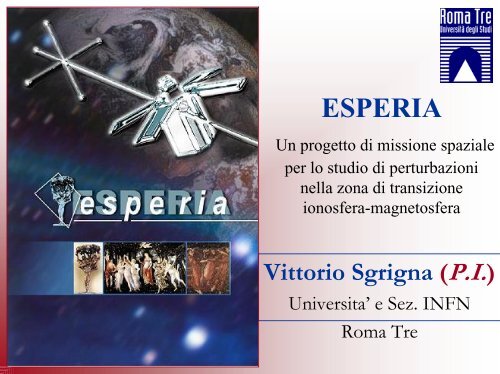
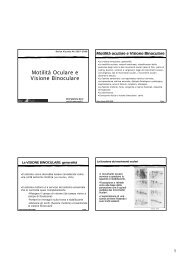
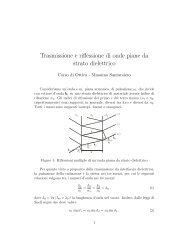
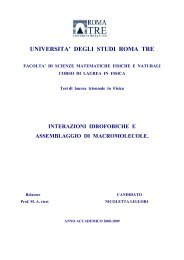
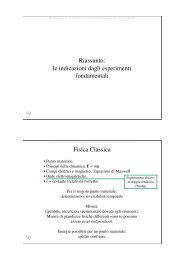
![Materiali_2012_dispense [modalità compatibilità]](https://img.yumpu.com/15881378/1/184x260/materiali-2012-dispense-modalita-compatibilita.jpg?quality=85)
